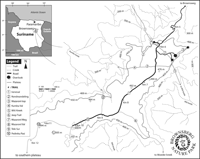Marilyn A. Norconk, PhD
Fieldwork Photos
Marilyn A. Norconk
Brownsberg Nature Park
Declaration prepared at the Association for Tropical Biology and Conservation annual meeting 2008, to request the government of Suriname to expand protection for Brownsberg and nearby mountains. In English and Dutch (translated by Bart DeDijn)
ATBC 2008 declaration - English - PDF • ATBC 2008 declaration - Dutch - PDF
"The Ark" Research Center
|
Publications
Norconk, M.A., Raghanti, M.A. Martin, S.K., Grafton, B.W., Gregory, L.T., and De Dijn, B.P.E. 2003. Primates of Brownsberg Natuurpark, Suriname, with Particular Attention to the Pitheciins. Neotropical Primates 11(2):94-100. [PDF 174KB]
Norconk, M.A. 2007. Report of 2007 field season (Jan to May, 2007) at Brownsberg Nature Park, Suriname to STINASU (Foundation for Nature Conservation in Suriname) and the Research Council of Kent State University. (PDF 369KB)
Brownsberg Ecological Research & Monitoring Program - 2001-2006:
excerpt: "Brownsberg Nature Park was established in 1970 and is Suriname’s first and only national park. Since its creation, the Park has become one of the most popular nature recreation areas in Suriname. ...
STINASU—the Foundation for Nature Conservation in Suriname—has been successful in promoting the Park as a recreation destination. ...
Equally critical—perhaps more so since it seeks to foster nature conservation in all of Suriname—is that opportunities be created at Brownsberg Nature Park for Surinamers to learn about nature. The Park hosted 17,000 mostly Surinamese visitors in the year 2001, which is equivalent to more than four percent of the total population of Suriname. ...
On-the-job training of Surinamers in ecological research can be undertaken at the Park, in conjunction with facilitation of research and monitoring by national and international research teams. This will yield skilled personnel and critical information. ...
The research and monitoring program for the Park will serve to:
1. Assess the “health” of the Park’s ecosystems and the conservation status of the Park, 2. Locate the flora, fauna, and ecological phenomena for the purpose of visitor education, 3. Expand the potential of the Park as a site for nature study, and 4. Strengthen scientific research across the Guayanas Region, e.g. by sharing methodologies, information and human resources." |
Links to: |
![]()

